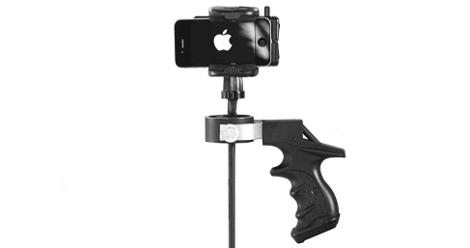
It’s been a while since we’ve seen a steadicam, and to quench our thirst is this iPhone 4 steadicam. The system does use the typical 3 axis PVC gimbal and heavy weight setup that we’ve seen before, but (why has it taken so long to get this implemented?) the addition of a hand grip means you no longer get blistered fingers. The tutorial recommends the use of an expensive cup holder mounting system, but we think making your own epoxy one might save another dime and allow a wider range of cameras or phones.
The whole process is also wrapped up in a quick and simple how-to video (after the jump alongside an in action video), which goes to show even though a hack may have been done several times before, presentation can make a big difference and impact.
[Thanks Max Lee]
Make your own:
[youtube http://www.youtube.com/watch?v=MKxMuwq22sM&feature=player_embedded%5D
See it in action:
[youtube http://www.youtube.com/watch?v=VQOL7igfbjA&feature=player_embedded%5D
















That’s smart, but it doesn’t handle vertical giggle.
would be good for any phone camera
problems: still a little jittery
CAN’T SEE WHAT YOU’RE FILMING
… my mistake you can see, i was confused by the HAD image
i made something like this for my D90 and a head for my flip … useful but when you see one you have seen them all and i have seen more than one here
Steadicam? Surely that’s Apple’s latest solution to the aerial problem? :-P
is the iphone cam really good enough for something like this?
But will it fix my reception problems due to crappy antenna?
A steadicam can’t help the fact that you are using a shitty capture device.
Its a ingenious solution to a problem but the aerial is the bigger problem lol good contraption though
This appears to have good X and Z stabling, but zero Y stabling. Lots of vertical bounce!
@Myke, well put, I looked at the footage and wondered why phone manufacturers, especially Apple, make video camera technology that creates footage in the same way as the first phones with video capture, ie the each frame is ‘slowly’ scanned from the camera sensor (much like a CRT displays a picture) rather than buffered and then fetched in one complete go, like a proper video camera.
Everyone that owns a camera always puts “My Name Photography”
Um, there’s an app for that!
Not to mention, the video is just not good enough to require a steady cam. Sort of like taking a Ford Pinto (R) to race in the Indy 500.
^ True.
Well executed and it solved his problem.
Regarding the concern about not being able to see what you’re filming. That’s really a non issue with a normal/wide angle lens. As long as the camera is pointed in the vicinity of the subject you’re going to get the shot. As the demo footage shows.
However it’s not much of a steady mount. Sure it’s got a cheap effective gimbal, but that’s really only half of the problem. As you saw in the demo the cameraman is limited to whatever pace they can walk at that doesn’t bounce the camera all around. Any time you move at normal walk or higher you get lots of vertical jitter.
For thirty bucks I can pay attention to my movements with the camera and get the same results.
Stabilizers are not just an add-on accessory that magically makes your shots stable. Steadicam® sells a training course (not just a video) with their professional rigs, because it’s just as important that the operator knows how to walk properly. The simpler rigs like this one that don’t have the camera suspended vertically are all susceptible to linear shake – all they correct is the angular motion. But even the high end ones require special training of the operator to be effective.
Wow, that’s like putting a spoiler on a moped.
It’s a freaking phone camera – nothing is going to turn it into real video.
I’m guessing Blair Witch Project 3 is in the works?
@Vonskippy, Blair Witch Project 3, LOL.
Here is footage from the iphone 4 found in black hills forest. Basicly crappy video of Coffin Rock.
Excellent way to take away the only real advantages a phone has over a real camera (size, weight).
@Haku:
Sounds like your talking about the rolling shutter, which is a problem all CMOS sensors have to some degree AFAIK. Many phones are really bad, as is the D90 for instance, but even many “real” video cameras these days really suffer from it.
Some things really were better in the good old (CCD) days.
Wow, I love how that out of focus, jittery crappy camera was able to move so smoothly!
Hello?
@cyr: ah, thanks, that’s what the technical term is :)
If I bought a ‘real’ video camera which turned out to have that I’d return it pretty quick, I really dislike rolling shutter footage, it looks dreadful and completely unnnatural.
Nice one! Good instruction video. How much would be the material round about?
The second demo video shows just how terrible the sound on the iPhone 4 is. Quite shocking.
Good music to cover it up though.
well the bad sound because it is not an appl… oh wait
Shouldn’t the center of gravity be in the gimbal?